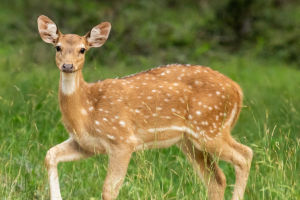Hummingbirds are birds native to the Americas.
They are among the smallest birds, with most species measuring 7.5-13 cm in length.
The smallest extant bird is a hummingbird, with the 5 cm bee hummingbird weighing less than 2.0 grams.
They are called hummingbirds because their beating wings produce a buzzing sound that can be heard at high frequencies as heard by humans.
They hover in mid-air at rapid wingbeat rates that vary from 12 beats per second for the largest species to a low of 80 beats per second.
In those species measured in wind tunnels, their maximum speed exceeds 15 m/s.
Some species can travel at more than 22 m/s.
Hummingbirds have the maximum mass-specific metabolic rate of any theropod.
To conserve energy when food is scarce, at night when they are not foraging, they can enter a state similar to hibernation, reducing their metabolic rate to 1/15th of the normal rate.
Hummingbirds are specialized carnivores and are associated with the bird pollen they feed on.
In some species, especially those with an unusual shape, the hummingbird is the smallest bird in the world to have evolved.
The dwarfism may be because it must compete with long-billed hummingbirds, which favor nectar foraging from specialized flowers, leading to more successful competition for floral foraging insects by honey hummingbirds.
As far as we know, male hummingbirds do not participate in nesting.
Most species build a cup-shaped nest in the branches of a tree or shrub.
Although some tropical species usually attach their nests to leaves.
Many hummingbird species use spider silk and lichen to bind nesting materials together and to ensure structural security.
As young hummingbirds grow, the unique nature of the silk allows the nest to expand.
Although it is the smallest of all bird eggs, it is large relative to the size of an adult hummingbird.
Incubation lasts from 14 to 23 days, depending on the species, and ambient temperature.
From south-central Alaska to Tierra del Fuego, which includes the Caribbean, hummingbirds are restricted to the Americas.
Most North American hummingbirds migrate south in the fall to spend the winter in Mexico, the Caribbean Islands, or Central America.
During the southern winter, some southern South American species also migrate northward to the tropics.
A few species are year-round residents of Florida, California, and the desert regions of the far southwest of the United States.
Red-brown hummingbirds breed further north than any other species.
Often breeding in temperate North America and increasingly overwintering in the subtropical Gulf of Mexico and Florida coast.
By moving north to the Yukon or southern Alaska in the spring, reddish-brown hummingbirds migrate more widely and roost further north than any other hummingbird species.
This hardiness allows them to survive below-freezing temperatures as long as they have adequate shelter and food.
Hummingbirds eat a wide variety of insects, including mosquitoes, fruit flies, and lice in flight or aphids on leaves and spiders in their webs.
To meet their energy needs, hummingbirds drink nectar, a sweet-tasting liquid found inside certain flowers.
Like honeybees, they can assess the sugar content of the nectar they eat.
They usually reject flower types that produce nectar with less than 10% sugar and dislike nectar with high sugar content.
Hummingbirds may be small in size, but they are among the most aggressive birds.
They regularly attack birds, crows, and hawks that encroach on their territory.
Backyard birdwatchers often find they have a dominant hummingbird that guards all feeders and chases intruders away.


